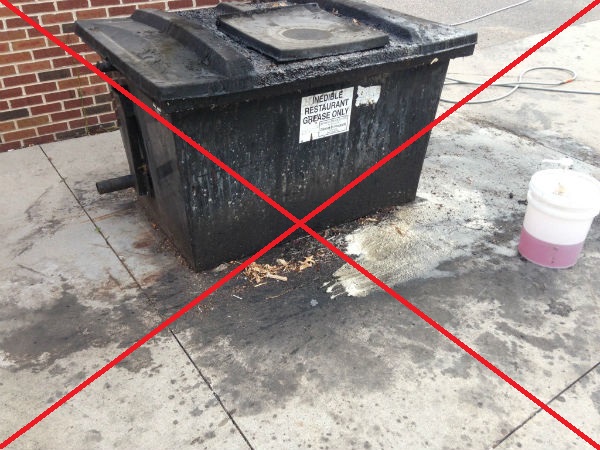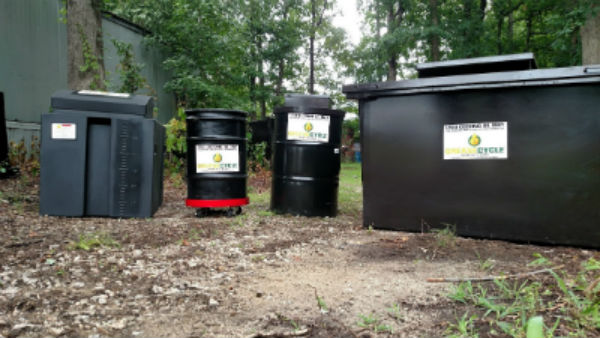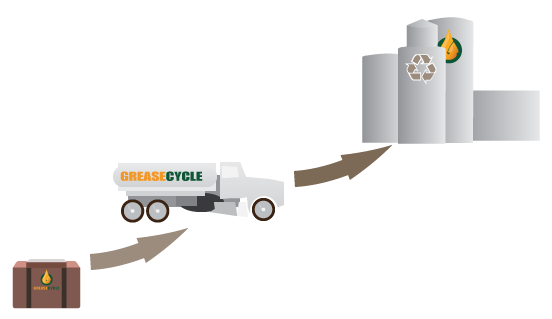Typically, a vendor will supply a grease container for your restaurant. Sometimes, the vendor will charge you a nominal monthly or quarterly "container rental fee."

What you want is to not have to pay anything for the container. You want the arrangement to be the other way around: The grease vendor will pay your restaurant for your used cooking oil.
Here's a quick guide on how to choose the kind of grease container that best fits the needs of your restaurant.
Considerations for Choosing Used Oil Containers
1. Used Oil Container Size
The size of your grease trap is important. If you have one or two fryers and only dump them once a week or less, a 50-gal lockable drum works fine. If you have a high-volume restaurant with 3 or more fryers, consider a 200 or 300-gal lockable metal container.

2. Grease Container Location
Tell your grease vendor to place the container in such a way that streamlines operations, minimizes spills and hides any potential unsightliness.
Consider which door your staff uses when exiting the kitchen while carrying the used cooking oil. Ask the vendor to place the container so that the path is as short as possible between the back door and the grease container location. Keep in mind that the location of the grease container gets dirty, so having it directly up against a building can be quite unsightly.
Often, the best location for a grease container is in the trash corral. If there is not enough space for a standard 300-gal grease container, then perhaps a 200 gal or 100-gal grease container would be more ideal. One advantage of the 100-gal plastic container is that it's slung lower. That makes it easier and safer for employees to lift up the grease and dump it into the container.
While these smaller containers help save space, they also require the hauler to service your location more frequently. In other words, your business might get disrupted if the haulers come during your restaurant's peak hours.

To sum it up, think carefully about the pros and cons of the grease container's location. Place it far away to minimize unsightliness. Make sure it's close enough to allow for a quick and safe transfer of the grease from the fryers to the grease container. Most importantly, make sure the size of container fits the desired location and is large enough to accommodate your volume needs.
What if you don't have any space for outdoor storage? There are a few options for storing spent fryer oil inside.
- One or two 35-gal indoor metal drums on wheels. These fit under a three-compartment sink.
- A plastic 55-gal rectangular container on wheels. These are more ergonomic and space efficient than the 35-gal drums. A rectangular container that fits into a rectangular space creates less "dead" space than a cylindrical container going into a rectangular space.
- Enclosed tank. These units are only viable if a restaurant is pumping out over 200 gal of used cooking oil per month. An indoor enclosed tank can range from 180 to 240 gallons in capacity. Unlike a traditionally used cooking oil container that has material dumped on the top of it, these units are enclosed and have used cooking oil pumped into them.
Enclosed indoor units may be free standing or plumbed.
- Free standing. These units require the restaurant to use its own oil filtration machine as a caddy. The oil is sucked out of the fryer, rolled to the collection unit location and pumped into the oil container.
- This unit eliminates one step from the free-standing version. Basically, as the name suggests, the fryers are plumbed to the unit. When the fryer oil must be changed, the operator opens the valve on the fryers and activates the pump to move the oil from the fryer to the oil collection unit through the plumbed piping.
These indoor units are convenient and help minimize the handling of hot oil. However, they are only financially viable if you're operating a high-volume restaurant. These units start at around $4,000 installed for the non-plumbed option and can cost up to $9,000.
The drawback of these units is that they can have technical issues. As with any other type of equipment, when you have machinery and moving parts, things will invariably wear out or break down. Although these issues can be resolved quickly, they often result in bottlenecks that can disrupt a restaurant's operations.
3. Enclosed Indoor Container Costs
Different grease collection companies have different financing options for restaurants looking to purchase grease containers.
Some companies pay to have the units installed at no upfront cost to the restaurant. However, the hauler maintains ownership of the container and pays the restaurant oil rebates at a steeply diminished rate. In other words, if you are getting poor service, you are essentially forced to put up with it.
Greasecycle takes a different approach. We pay for the container up front, then lease it back to the restaurant over a 7-year period, after which clients can buy the unit for $1., The restaurant pays Greasecycle a monthly leasing fee until the container is paid off. At the same time, Greasecycle pays the restaurant the full oil price rebate during the abovementioned period.

4. Grease Container Security
It sounds crazy, but people steal grease. Whether it's someone who's converted their VW to run off pure vegetable oil or nefarious outfits that have their own vac trucks, people will take your grease unless you and your grease vendor do something about it.
The indoor containers are obviously the most secure. The second most secure is the 200-gal and 300-gal lockable boxes. Although the 100-gal plastic container is lockable, it's not very durable as it's made of plastic.
Here's a table to help you figure out which type of container is best for your restaurant.
| Space Economy | Security | Ease of Use | Minimizes Hazards | Free for Restaurant | |
| 50 gal drum (w/ lockable topper) | yes | somewhat | no | no | yes |
| 35 gal drum (indoor) | yes | yes | no | somewhat | yes |
| 200 or 300 gal box | no | yes | no | no | yes |
| 100 gal plastic box | yes | no | yes | no | yes |
| Indoor enclosed tank | no | yes | yes | yes | no |
As you can see, choosing the right grease container or used cooking oil container for your restaurant is crucial. With the right container, you can help keep your restaurant free of grease, while complying with local FOG standards at the same time.